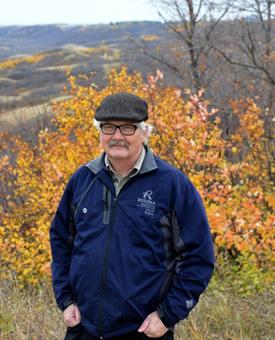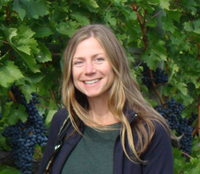Poetry as Surrender to Beauty:
Samantha Ainsworth in Conversation
with Bruce Rice

Malahat poetry intern Samantha Ainsworth talks with Bruce Rice, winner of the 2014 P. K. Page Founders' Award for Poetry. Rice won this year's award for his poem "Into the Wind," which appeared in Issue #183, Summer 2013.
“Into the Wind” reads sideways along each page; its gentle lines trail out like long hair or loose clothing worn by a person marching headlong into a strong wind. Can you elaborate on this choice of poem shape, and use of white space on the page?
Well, we do like leaning into the wind here. The length of the line is really about the breath, the extended rhythms that fit the distances and the contemplative voice of the poem, which is an elegy. But I also like the idea of the generosity of the long line, as opposed to shortline poems which can muster a lot of intensity, but they can also be reductive when the subject asks for more. I am a big fan of vernacular, and Dennis Cooley has written about the generosity of this kind of voice and speech. As for the space around the poem, it allows different ideas and images to be “seen” within the overall movement of the poem. Even though the subject is rather dark, the language is subdued and the air around the poem makes it accessible to the reader, and I think helps the pacing.
Landscape is prevalent in “Into the Wind”: “the trek to the bluff,” “The brow of the coulee,” “the river,” “the gap in the hills,” and “the deep snow out on the fallow.” Can you explain your poem’s connection between landscape and the concept of permanence?
To answer at a purely gut level, my overall sense when I am standing in the kind of place where you can see for miles, there is an overwhelming sense of timelessness and permanence. We’re the ones being blown around, not the land or even the grasses, which always come back. Life is always close, and death is close as well and often random. But still, we choose to live such places.
When I travel I am drawn to extreme edges of wherever I happen to be. When the Inuit leave their settlements to go to stay in their summer camps, they translate it as going to live in the land. They see themselves as part of the land, which perhaps transcends the question of permanence or impermanence. I haven’t achieved it, but it’s a path that I’ve been on as a poet, and it’s hopeful to know that such a moment exists.
"Into the Wind,” elegiac in form, pushes into the past. Its speaker, on a vision quest of sorts, returns to the place of his childhood where he and his siblings play a game, “Double the Rent.” Each player has his place in the game, and is an essential link in the chain. The speaker’s life is altered significantly by the loss of a brother. Can you speak about this loss of connection and need to mend the gap?
The circumstances of his death were never clear, but then, neither was his life since he left home quite young. In many ways, we were close strangers for perhaps half a dozen years and part of the back-story that led to the poem was the work to fill in the details of a life I barely knew. Some of what ended up on the page is my own projection, but even that is true, a kind of balm that helps the poem to go where it has to. To me, it is as much about understanding our roles in the drama and recovering what one can — the truth — as it is about letting go.
You have achieved recognition and success with your poetry. In 2009, your collection of poems, Life in the Canopy (Hagios Press), was shortlisted for Saskatchewan Book of the Year. You also received the Canadian Authors Association Award for poetry with your collection, Daniel, and had your work broadcast on CBC Radio. Have you worked consistently in the realm of poetry, or have you written in any other genres?
I am mostly a “pure poet.” I have started to write some creative nonfiction, which feels like a short step from poetry. I have also worked on the fringes of film. It has been a very modest effort so far but I hope to get into it more in the future. I have been involved in a fair number of collaborations. The most recent one involved poetry, music, and dance with film shot in the Qu’Appelle Valley projected on the dancers. When I’m working in collaborations with other artists, it feels like the scale of the work is starting to match the scale of the imagined poem in my head. It’s great to see the response and how receptive people are to poetry presented in this way.
In 2013 you published Dorothy McMoogle with Kumquat and Bugle (Wild Sage Press), a children’s storybook in rhyme. How was this experience for you?
A ton of fun. I haven’t worked with young kids for a long time, and it’s like getting back to my roots when I used to help a friend in drama workshops in schools, long before I started to write. The artist, Wendy Winter, was selected by Wild Sage Press. I knew her from the community; our kids were mutual friends, but I had never seen her work. She riffed quite wonderfully on the poem and now her granddaughter, who modeled for the illustrations, is a bit of a star in the neighbourhood. Once you’ve been through the process, you can really see why the artist and the writer get equal credit on a children’s book. I love the collaboration.
Your fifth book of poetry, The Trouble with Beauty (Coteau Books), will be released later this month. Can you tell us a little about it?
After Life in the Canopy came out, I wasn’t really trying to write a new book. I just started driving to a place called Seven Bridges Road in the Qu’Appelle Valley where I have picked wild rosehips and Saskatoons with some friends. I began to write and take a few pictures. I was very conscious about trying to capture the place as precisely as I could without imposing the ego of the poet on the poem. I simply went back to the road every chance I got and wrote about what was there. About a year later, I saw a retrospective on the work of photographer Robert Adams in the Vancouver Art Gallery. Adams’ work was part of the seminal exhibit on the “new topographics” at George Eastman House in 1975, which changed the course of landscape photography.
The hard question he asks is: given all we have done to the land we settled and the romanticized images of the wild places we’ve despoiled, “How can art be more than lies?” I love the pleasures of the landscapes and latitudes the book travels through, the prairie and the North, but Adams’ troubled question is always present, sometimes as foreground, sometimes as background.
A gentle voice runs through “Into the Wind.” This meditative tone carries strength, allowing comfortable access into a theme that alludes to the frailness and beauty of life, and to the bonds never completely severed by separation or death. Has this theme been explored in your other poetry?
Each of my books is very different. There are often themes of exile, exclusion and resistance, particularly on the part of family women who refuse to be victims. There’s a blend of willfulness and contemplation running through their voices. They would resent having themselves or their lives described as frail. But lately I have been writing more in the quiet moment. The pause I give to “the poet” is a pause I give to myself. I think I do write more about mortality than I used to. I suppose it is natural as one gets older.
As for Beauty itself, it is something I have been preoccupied with for the past few years. It is often strong and present in our lives and the places we love, rather than frail or ephemeral. The word carries a lot of baggage from the Romantics. I have tried to develop a new vocabulary of strokes―as a painter might say―and it has given me pleasure in the writing that I hope comes out in the work. Partly to encourage others and partly to remind myself, I have started to say that I became a better poet when I finally surrendered to beauty.

Samantha Ainsworth
* * * * * * * *









